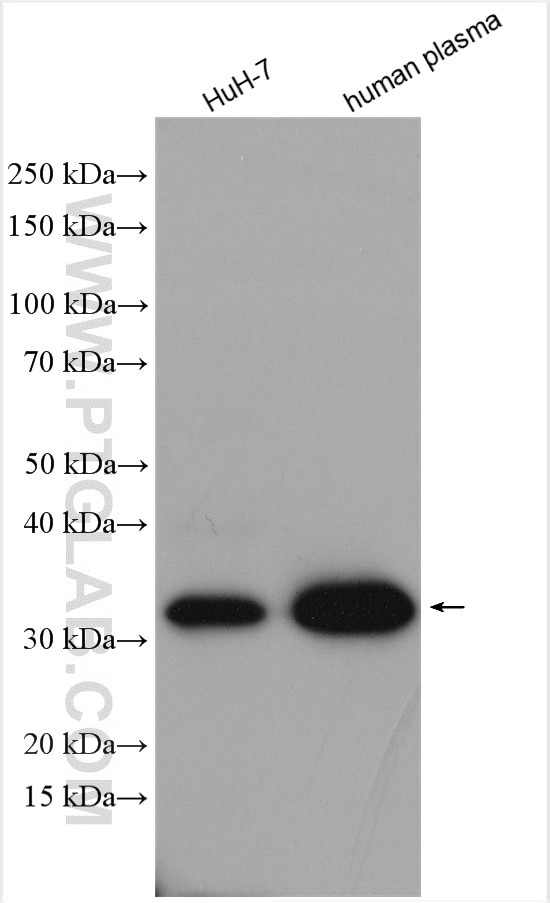- Phare
- Validé par KD/KO
Anticorps Polyclonal de lapin anti-APOE
APOE Polyclonal Antibody for WB, IF, ELISA
Hôte / Isotype
Lapin / IgG
Réactivité testée
Humain et plus (1)
Applications
WB, IHC, IF/ICC, ELISA
Conjugaison
Non conjugué
N° de cat : 18254-1-AP
Synonymes
Galerie de données de validation
Applications testées
| Résultats positifs en WB | cellules HepG2, cellules HuH-7, plasma humain |
| Résultats positifs en IF/ICC | cellules HepG2, |
Dilution recommandée
| Application | Dilution |
|---|---|
| Western Blot (WB) | WB : 1:1000-1:6000 |
| Immunofluorescence (IF)/ICC | IF/ICC : 1:200-1:800 |
| It is recommended that this reagent should be titrated in each testing system to obtain optimal results. | |
| Sample-dependent, check data in validation data gallery | |
Applications publiées
| WB | See 12 publications below |
| IHC | See 3 publications below |
| IF | See 4 publications below |
Informations sur le produit
18254-1-AP cible APOE dans les applications de WB, IHC, IF/ICC, ELISA et montre une réactivité avec des échantillons Humain
| Réactivité | Humain |
| Réactivité citée | Humain, souris |
| Hôte / Isotype | Lapin / IgG |
| Clonalité | Polyclonal |
| Type | Anticorps |
| Immunogène | APOE Protéine recombinante Ag13070 |
| Nom complet | apolipoprotein E |
| Masse moléculaire calculée | 36 kDa |
| Poids moléculaire observé | 34-38 kDa |
| Numéro d’acquisition GenBank | BC003557 |
| Symbole du gène | APOE |
| Identification du gène (NCBI) | 348 |
| Conjugaison | Non conjugué |
| Forme | Liquide |
| Méthode de purification | Purification par affinité contre l'antigène |
| Tampon de stockage | PBS avec azoture de sodium à 0,02 % et glycérol à 50 % pH 7,3 |
| Conditions de stockage | Stocker à -20°C. Stable pendant un an après l'expédition. L'aliquotage n'est pas nécessaire pour le stockage à -20oC Les 20ul contiennent 0,1% de BSA. |
Informations générales
The apolipoprotein E (APOE) is a 299-amino acid polypeptide that mediates the binding, internalization, and catabolism of lipoprotein particles, and also serves as a ligand for the LDL (apo B/E) receptor and for the specific apo-E receptor (chylomicron remnant) of hepatic tissues. The very strong association of the APOE ɛ4 allele with AD risk and its role in the accumulation of amyloid β in brains of people and animal models solidify the biological relevance of APOE isoforms but do not provide mechanistic insight. APOE can be detected 43kDa and 69kDa dimers (PMID: 9831633).
Protocole
| Product Specific Protocols | |
|---|---|
| WB protocol for APOE antibody 18254-1-AP | Download protocol |
| IF protocol for APOE antibody 18254-1-AP | Download protocol |
| FC protocol for APOE antibody 18254-1-AP | Download protocol |
| Standard Protocols | |
|---|---|
| Click here to view our Standard Protocols |
Publications
| Species | Application | Title |
|---|---|---|
Br J Cancer A new panel of pancreatic cancer biomarkers discovered using a mass spectrometry-based pipeline. | ||
Transl Oncol Multi-omics analysis-based macrophage differentiation-associated papillary thyroid cancer patient classifier | ||
bioRxiv SARS-CoV-2 desensitizes host cells to interferon through inhibition of the JAK-STAT pathway. | ||
Life Sci Effects of apolipoprotein E on regulating insulin sensitivity via regulating insulin receptor signalosome in caveolae |




